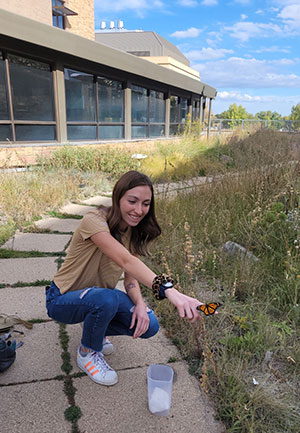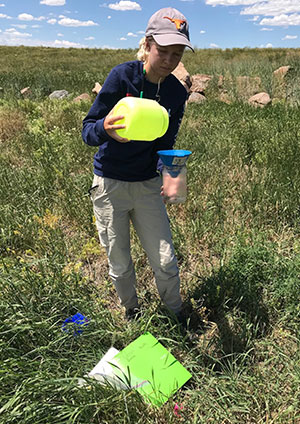
Contact Us
Institutional Communications
Bureau of Mines Building, Room 137
Laramie, WY 82071
Phone: (307) 766-2929
Email: cbaldwin@uwyo.edu
UW Researchers Team Up With Girl Scout to Study Bee Sampling Methods
Published September 29, 2023

Zoe Short shows off a monarch butterfly she named Russell in front of UW’s Berry
Biodiversity Conservation Center pollinator garden. Short, a recent UW graduate from
Douglas, was the lead author of a paper that investigated what methods are most effective
at capturing and monitoring bees and other pollinators. The paper, which recently
appeared online in the journal Prairie Naturalist, will be published in print later
this year. (Lusha Tronstad Photo)
Many insect species that are declining -- such as bees -- are essential pollinators, and more information is needed to determine the best method to sample and monitor their numbers.
In a unique collaboration, a University of Wyoming research team worked with a Girl Scout to produce results that can help managers and researchers choose the best methods to collect their target insects or design a monitoring program.
“Our goal is to investigate which methods are most effective at capturing and monitoring bees and other pollinators. Few studies have compared vane traps with different shapes of pan traps,” says Lusha Tronstad, lead invertebrate zoologist with UW’s Wyoming Natural Diversity Database (WYNDD). “Most studies focus on bees, but we felt measuring the catch of other insects was critical because that information can help us tailor our methods to the insect of interest and figure out which traps catch mainly the insect of interest.”
Tronstad was last author of a paper titled “Vane Traps Collected More Bee Genera and Less Bycatch of Other Insects Compared to Pan Traps” that will be published in print later this year in Prairie Naturalist, a peer-reviewed natural history science journal for the North American Great Plains. The paper was published online Sept. 14.
During the study, insects were collected in the Laramie Valley in summer 2019. Insect abundance and bee richness were compared among three sampling capture methods -- using vane traps and two types of pan traps: bee cups and bee bowls. Pan traps were colored yellow, white and blue. Trap types were placed at least 20 meters apart. All three trap types and colors were deployed for 48 hours during each visit.
“We showed that vane traps are the most efficient at collecting bees. Pan traps are the traditional go-to method for researchers studying bees, and vane traps are a newer method,” Tronstad says. “Vane traps are larger and usually hung higher and, thus, more visible, which may help attract bees to them. Pan traps are known to be very good at collecting sweat bees but not so effective at catching other types of bees.
“We showed that vane traps collect a wider variety of species with less effort,” she continues. “Pan traps are usually placed on the ground and filled with water. Additionally, vane traps are faster to process in the laboratory because they are not collected in a liquid.”
While this study is a good start, Tronstad says more studies are needed to cover more geographic spaces.
“This study sampled in southeastern Wyoming, and sampling across more ecosystems and elevations would be ideal,” she says. “We hope others will repeat our study to see if results are consistent in other areas.”
A Unique Collaboration
Tronstad guided the project, in which she collaborated with two of her former UW students as well as Kieran Burns, a Girl Scout and Laramie High School sophomore-to-be at the time of the study. Burns had reached out to Tronstad to work together on the study for Burns’ Girl Scouts of America Gold Award project.

Kieran Burns, a former Girl Scout and Laramie High School student, empties a vane
trap to check its contents for bees and other insect pollinator samples at the Wyoming
Territorial Prison during summer 2019. Burns asked Lusha Tronstad, lead invertebrate
zoologist with UW’s Wyoming Natural Diversity Database, to collaborate with her on
her Girl Scouts of America Gold Award project. (Lindsay Burns Photo)
“I worked with the Girl Scouts of America years ago on a community science project, where we sampled the Laramie River after restoration efforts,” Tronstad recalls. “I met Kieran then, and she contacted me about working on her Gold Award project.”
Zoe Short, a UW undergraduate student from Douglas who graduated this past spring, was the paper’s lead author. Short, who is now enrolled in veterinary school in Edinburgh, Scotland, analyzed the data and wrote the manuscript. The project was part of her undergraduate research project supported by the Wyoming Research Scholars Program.
Christine Bell, who graduated from UW with her master’s degree in zoology in 2019 and is from Laramie, also was part of the study. At the time, Bell was working in Tronstad’s laboratory and was studying how different bee collections differed.
Burns collected all of the study’s insect samples. Tronstad, Short and Bell assisted Burns in designing the study.
“I really enjoyed doing the research. One of the biggest things I took away from helping out with the project is that a study is composed of so many moving parts,” says Burns, now a sophomore majoring in biology at the Air Force Academy. “Just putting insect traps in the prairie didn’t constitute research. Rather, the insects we collected had to be properly stored, cleaned, sorted, pinned, studied and so much more. Additionally, I learned a lot about how studying something you love can feel a lot more like play than work. This project definitely fostered an enjoyment for fieldwork for me, and I was super proud to be helping out real entomologists.”
Burns concluded her Gold Award project -- the highest honor a Girl Scout can achieve -- by teaching the next generation of young Girl Scouts about the importance of pollinators through a virtual workshop, which spoke to the sustainability factor of the project.
“It was very interesting to have a Girl Scout be involved with the study. The entire study design and data collection was Kieran’s brilliant work,” Short says. “I feel lucky to have been able to analyze and write up all of her hard work. Her study idea was well thought out and contributes greatly to our small understanding of Wyoming’s native bee species.”
“We came together and collected valuable information as a team effort,” Tronstad says. “I’m proud of all of them.”
About the Wyoming Natural Diversity Database
WYNDD offers the most complete source of data for species and vegetation communities of management concern in Wyoming. Its mission is threefold: Identify and rank species that are priorities for management in Wyoming; amass existing data and develop new data for species needing management efforts, and for Wyoming vegetation types; and distribute these data upon request, under the philosophy that the best decisions regarding natural resources will be made only when everyone has access to complete and current scientific data.
Contact Us
Institutional Communications
Bureau of Mines Building, Room 137
Laramie, WY 82071
Phone: (307) 766-2929
Email: cbaldwin@uwyo.edu
